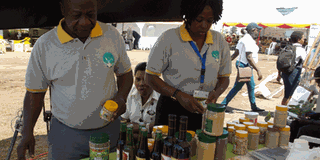Kasozi’s pumpkin wine a great deal

Mr Henry Kasozi and aide display pumpkin wine and other pumpkin products at their stall during World Food Day activities in Rubanda District. Photo by Michael J Ssali
What you need to know:
- Peter Kasozi is generating income after adding value to the pumpkin, writes Michael J Ssali.
For Peter Kasozi of Kalangaalo Village near Mityana Town, pumpkin is not just a fruit to be steamed and served as food although even doing this would be good enough to fill the tummy.
“So many farmers sell their pumpkins to consumers and traders as whole fruits at the farm gate price of between Shs500 and Shs1,000 which is still profitable given that, with good husbandry, a farmer may harvest close to six thousand pumpkins from just an acre,” Kasozi said during the national activities to mark World Food Day at Karengyere Demonstration Farm in Rubanda District on Monday.
That means a pumpkin farmer may earn as much as Shs6m from one acre, according to him. However, the pumpkin crop can be even far more profitable if it is sold in its many other forms because it is food, medicine, and a good raw material for wine making.
That is how Kasozi who grows the pumpkin on 10 acres in Kalangaalo village, Mityana District has improved his profit margins.
Turning point
Kasozi started processing wine from pumpkins in 2015 when he acquired knowledge from scientists after attending a workshop on value addition in Kampala.
“After the workshop I conducted further research and started making my wine which is selling like a hotcake,” he says.
Cost and market
Kasozi reveals that a big bottle of his wine costs Shs20,000 while the medium size goes for Shs10,000. “The wine is very profitable and today I make more than I used to before value addition,” he reveals. Most of the wine is on market in Kampala and major towns. “We supply supermarkets who sell on our behalf,” he says.
The pumpkin powder costs Shs5,000 per big tin. “We supply hotels in Kampala and every weekend our sales executives collect the money,” he says.
Challenges
Kasozi decries unreliable market as the major hindrance to his innovations. He blames the challenge on perception. “Some Ugandans have not accepted our products,” he says.
The process
Kasozi shares the process as follows:
•Wash, peel and grin the pumpkin and then place in the primary fermentor.
•In the primary fermentor, add raisins, spices and boiling water, cover the solution for 12 hours. “We peel and shred the pumpkins and mix it with the raisins before adding the spices,” notes Kasozi.
•Add all other ingredients except yeast. Remember the original recipe includes one campden tablet potassium metabisulfite – used to reduce the risk of spoilage.
•Stir well to dissolve sugar. Specific gravity should be between 1.090 and 1.095. Sprinkle yeast over the mixture and stir. Stir daily for three to five days, until specific gravity is about 1.040.
• The mix will get bubbly, and should have a pleasant, mildly yeasty smell.
•At the end of this first ferment, the pumpkin will have turned to mush and the pumpkin will be plump. Strain the must and squeeze out as much juice as you can.
• Siphon into a secondary fermentor, make up to volume with water and attach airlock.
•For a dry wine, rack in three weeks, and every three months for one year. The bottle it.
•For a sweet wine, rack at three weeks. Add half cup sugar dissolved in one cup wine. Stir gently, and place back into secondary fermentor. Repeat process every six weeks until fermentation does not restart with the addition of sugar.
•Rack every three months until one year old.
The wine is best if you can refrain from drinking it for one full year from the date it was started.
Pumpkin seeds
Besides the wine, Kasozi also packages the seeds. The seeds are rich in protein and are a high value product too—they are currently sold in several supermarkets in Kampala.
“Because of their medicinal traits, the seeds are very profitable. We extract them from the pumpkins, dry and roast them before packaging for distribution,” he says.
Pumpkin powder
Pumpkin powder is the other product. Kasozi produces the powder after drying the pumpkins.
“Upon harvesting the pumpkins from the farm, we chop them into slices using sharp knives. We then spread them on the dryer for about one week of intensive heat,” Kasozi explains.
The next step is milling them. “We managed to acquire a grinding mill under the Nkokonjeru Cooperative Enterprises. This mill is so vital for the farmers,” he says.
The powder which is used for porridge and soup is also distributed in major supermarkets in Kampala and Mityana Districts.




